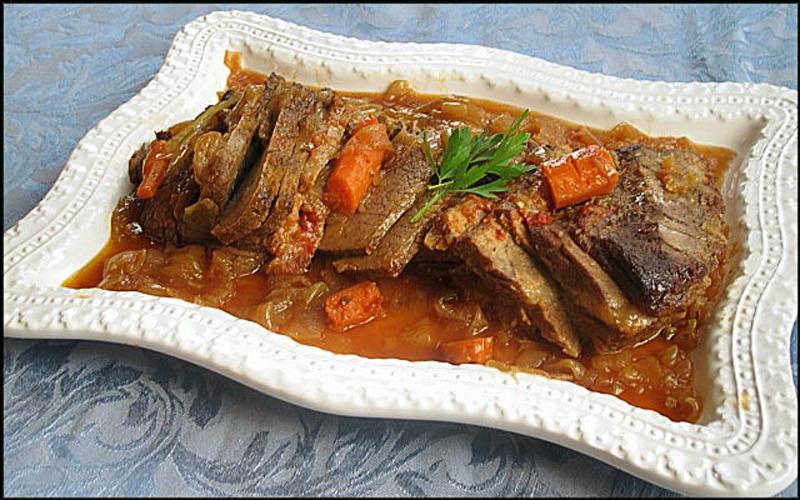Traditional and modern beef brisket recipes share some aspects
In last week’s newspapers and several online blogs, the subject covered in a wide range of articles was beef brisket, likely due to the upcoming Jewish holy days of Rosh Hashanah and Yom Kippur. The first of these marks the beginning of the Jewish New Year with 10 days of prayer and penitence, culminating on Yom Kippur, known as the Day of Atonement.
There are many theories about why beef brisket became associated with Jewish holidays, from the need to purchase only kosher cuts of beef to the lower cost of brisket compared to other cuts. These tougher pieces that come from the well-used chest muscles require a long cooking time to become fork-tender, and they actually benefit from being cooked and reheated.
The most amusing aspect of the spate of recipe columns about brisket was that they all claimed to be old family recipes from a beloved aunt or grandmother and completely original as the best way to cook the meat. They ranged widely in complexity, as well. Grandma Blanche’s Brisket in the Wilmington News Journal called for only three ingredients, while the Washington Post featured a recipe from food writer Olga Massev’s mother-in-law which listed over a dozen to complete the multi-step process.
They had other differences, but also shared a few features in common. First was the need for aggressive seasoning from a tomato-based product, whether ketchup, chili sauce, canned tomato sauce, or (my favorite) tomato paste. Onions are essential, typically chopped and sliced or added from a dried soup packet. I have seen recipes that call for soy sauce or cola soda, and most ask for garlic, either fresh or in dried powder form.
The one commonality (except for Grandma Blanche) is the cooking process: long and slow, which translates to several hours in a low-temperature oven. Often, this includes an overnight rest in the refrigerator before the final round of heat, and the meat is usually sliced before this last period of cooking, rather than at the table. The reason is that the partly cooked and chilled brisket is easier to slice cold and less likely to fall apart, as it does when completely cooked.
There is ample debate about which part of the brisket is most delicious of the two sections sold, the point or the flat. The top piece is called the deckle or point; the bottom, leaner section is sold as first cut or flat. These are typically trimmed of some fat, but properly butchered brisket will retain a layer of surrounding fat. As you cook it, all that connective tissue melts away, leaving behind succulent, tender beef.
I have included two recipes for you to consider, the one in the photo that incorporates the two-step cooking process, and the simpler version from Grandma Blanche. A favorite side to serve with brisket is potato pancakes topped with applesauce. If you can’t cut perfect slices once it’s fully cooked, keep in mind that brisket-lovers insist the sign it’s perfectly cooked is that it’s too tender to slice.
Twice-baked Beef Brisket
3 lb flat brisket
1 t flour
black pepper
1 T olive oil
4 onions, thickly sliced
1 T beef broth
2 quartered garlic cloves
3 chopped carrots
2 T tomato paste
Preheat oven to 375 F. Dredge the brisket in flour and coat thoroughly with pepper. Heat the oil in a Dutch oven over medium. Brown the meat, turning once; remove to a platter. Add onions to the pan and cook, stirring often, for about 10 minutes. Add a splash of beef broth to deglaze the pan, stirring to incorporate the browned bits. Place the brisket on top of the onions. Scatter garlic and carrots around the meat. Coat the meat with a layer of tomato paste; cover pan and bake for 90 minutes. Remove pan from the oven and allow to cool for at least one hour. Place covered pan in the refrigerator overnight. The next day, remove any bits of congealed fat on top of the meat and vegetables. Preheat oven to 275. Place brisket on a cutting board and cut into 1/3-inch slices. Return brisket to the pan, overlapping the slices. Cover and bake until tender, about 2 hours. Yield: 6 servings.
Grandma Blanche’s Brisket*
1 large can ShopRite tomato sauce
2 1/2 - 3 lb brisket
1 packet onion soup mix
Preheat oven to 400 F. Line the bottom of a roasting pan with a layer of tomato sauce. Rub the outside of the brisket with the contents of the soup packet and set in the roasting pan. Pour the remaining tomato sauce over the meat. Fill the can halfway with water and add to the pan. Cover tightly with aluminum foil and cook until tender, at least 2 hours. Yield: 8 servings. *Adapted from Jaime Walters in the Wilmington News Journal.
























































